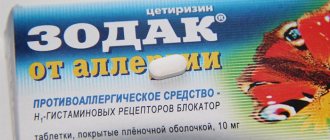Cetirizine, drops
Dosage regimen
Adults and children over 12 years old
The recommended dose is 10 mg (24 drops) once daily.
Children 6-12 years old
The recommended dose is 5 mg (12 drops) twice daily.
Children 2-5 years old
The recommended dose is 2.5 mg (6 drops) twice daily.
Children from 1 year to 2 years
The recommended dose is 2.5 mg (6 drops) once or twice daily.
Children from 6 months to 1 year
The recommended dose is 2.5 mg (6 drops) once daily.
The maximum duration of treatment in children with seasonal rhinitis should not exceed 4 weeks.
Special patient groups
Elderly
According to available data, with normal renal function, age is not a reason to reduce the dose.
Patients with impaired renal function
There is no data confirming the effectiveness/safety of the drug in patients with impaired renal function. Since cetirizine is mainly excreted through the kidneys (see section “Pharmacokinetic properties”), if it is impossible to use alternative treatment, the dose of the drug should be selected individually, taking into account renal function. The table below helps you choose the right dose. To use this table, it is necessary to determine creatinine clearance (CC) in ml/min. To do this, it is necessary to determine the serum creatinine level and calculate CC using the following formula:
CC = [140 - age (in years)] x weight (kg) (x 0.85 for women)
72 x serum creatinine (mg/dL)
Dose adjustment in patients with impaired renal function:
| Group | CC (ml/min) | Dose and frequency of administration |
| Normal kidney function | >80 | 10 mg (24 drops) 1 time/day |
| Mild renal impairment | 50-79 | 10 mg (24 drops) 1 time/day |
| Moderate renal impairment | 30-49 | 5 mg (12 drops) 1 time/day |
| Severe renal impairment | 10-29 | 5 mg (12 drops) once every two days |
| End stage renal failure, dialysis | <10 | Contraindicated |
For children with impaired renal function, the dose should be selected individually, taking into account renal clearance, as well as the age and body weight of the patient.
Patients with impaired liver function
In patients with only liver dysfunction, there is no need for dose adjustment.
Patients with impaired liver and kidney function
Dose adjustment is recommended (see section “Patients with impaired renal function” above).
Mode of application
Drops for oral administration.
The use of the drug does not depend on food intake (see section “Pharmacokinetic properties”).
The solution should either be dripped into a spoon or diluted with water and taken orally. If the solution is diluted with water, then it should be taken into account that the volume of liquid used to dissolve the drug corresponds to the amount of liquid that the patient is able to drink. This is especially important when dosing the drug to children.
Cetirizine FT
- Pharmacodynamics Cetirizine is a piperazine derivative and is a carboxylated metabolite of hydroxyzine. Cetirizine has selective antagonism of peripheral H1 receptors and has a pronounced antiallergic effect. Has antipruritic and antiexudative effect. It has almost no effect on other types of receptors, does not have anticholinergic and antiserotonergic effects. Cetirizine affects the “early” histamine-dependent stage of the allergic reaction, and also limits the release of inflammatory mediators at the “late” stage of the allergic reaction, and has an anti-inflammatory effect. It reduces the migration of eosinoyls, neutrophils and basophils, stabilizes the membranes of mast cells. Reduces capillary permeability, prevents the development of tissue edema, and eliminates spasm of smooth muscles. Eliminates skin reaction to the introduction of histamine, specific allergens, cooling, reduces histamine-induced bronchial obstruction in mild bronchial asthma. Cetirizine is less lipophilic compared to hydroxyzine, practically does not penetrate the blood-brain barrier and does not act on H1 receptors in the central nervous system. In therapeutic doses it does not have a sedative effect. After taking 10 mg of cetirizine, the effect develops within 20 minutes in 50% of patients, after 60 minutes in 95% of patients and lasts more than 24 hours. With repeated doses, addiction to the drug does not develop. After discontinuation of treatment, the effect persists for three days.
Pharmacokinetics Absorption: After oral administration, cetirizine is rapidly and completely absorbed from the gastrointestinal tract. Cmax in blood plasma is reached within 1.0±0.5 hours and is approximately 300 ng/ml. When taken simultaneously with food, the completeness of absorption does not change, but its rate decreases. The equilibrium state is achieved on the third day. In volunteers, pharmacokinetic parameters such as Cmax and AUC are unimodal. The degree of bioavailability is similar when cetirizine is used in the form of a solution, tablets or capsules. In the dose range from 5 to 60 mg, the pharmacokinetics are linear.
Distribution: In adults, after taking 10 mg of the drug orally and in children after taking 5 mg of the drug, the volume of distribution is approximately 35 l (0.5 l/kg) and 17 l, respectively. The binding of cetirizine to plasma proteins is 93±0.3%. Cetirizine does not alter the binding of warfarin to blood proteins. When taking 10 mg/day for 10 days, no accumulation of the drug was observed.
Metabolism: Cetirizine does not undergo first-pass metabolism. In small quantities, it is metabolized in the liver by O-dealkylation to form a pharmacologically inactive metabolite (unlike other H1-histamine receptor blockers, which metabolize with the participation of the cytochrome P 450 system).
Excretion: About 2/3 of the administered dose of cetirizine is excreted unchanged from the body in the urine. The half-life in adults is about 10 hours, in children 6-12 years old - about 6 hours, in children aged 2-6 years - 5 hours, from 6 months to 2 years - 3.1 hours. After taking 10 mg of the drug in adults, total clearance increases to 0.6 ml/min/kg. in children after taking 5 mg - up to 0.93 ml/min/kg. After discontinuation of cetirizine, its blood level quickly decreases to undetectable low values.
In elderly patients and patients with chronic liver dysfunction, after a single dose of cetirizine at a dose of 10 mg, T1/2 increases by approximately 50%, and clearance decreases by 40% compared to middle-aged patients. In patients with mild renal impairment (creatinine clearance > 40 ml/min), the pharmacokinetic parameters of cetirizine are similar to those in healthy volunteers. In patients with moderate renal failure and in patients. patients on hemodialysis (creatinine clearance < 7 ml/min), a single dose of 10 mg of the drug led to a threefold prolongation of T1/2 and a decrease in clearance by 70%, which requires dose adjustment. Cetirizine is not removed from the body by hemodialysis.
Side effects
Taking an antihistamine may be accompanied by side effects. More common:
- Stool disorder.
- Excitement, nervousness.
- Asthenia.
- Skin rashes, itching, swelling.
- Parasthesia.
- The following side effects occur less frequently:
- Quincke's edema, urticaria.
- Urinary dysfunction.
- Increased body weight.
- Movement disorders.
- Drowsiness or insomnia.
- Loss of consciousness.
- Depression, aggression.
- Increased heart rate.
- Signs of hepatitis.
Composition and release form
The drug is available in the form of tablets and drops for oral administration.
The tablets have a special soluble coating. Packaged in paper packaging with attached instructions for use.
The drops are a light liquid. Sold in bottles of 10 or 20 ml.
The active ingredient is cetirizine dihydrochloride. Its content in tablets and drops is 10 mg.
Excipients: magnesium stearate, silicon dioxide, lactose in tablets. Also benzoic acid, glycerol, sodium acetate, propylene glycol and pure water in the form of drops.
Cetirizine drops for oral administration 10 mg/ml bottle, 20 ml (Ozone)
Registration Certificate Holder
ATOLL (Russia)
Dosage form
Medicine - Cetirizine
Description
Drops for oral administration
in the form of a clear, colorless or slightly brownish solution with a characteristic odor.
1 ml
Cetirizine dihydrochloride 10 mg
Excipients
: methyl parahydroxybenzoate - 1.35 mg, propyl parahydroxybenzoate - 0.15 mg, glycerol - 250 mg, propylene glycol - 350 mg, sodium saccharinate - 10 mg, sodium acetate trihydrate - 10 mg, glacial acetic acid - 0.53 mg, water - up to 1 ml.
10 ml - dark glass dropper bottles (1) - cardboard packs. 20 ml - dark glass dropper bottles (1) - cardboard packs.
Indications
Hay fever; allergic rhinitis, conjunctivitis, dermatitis; urticaria, Quincke's edema.
Contraindications for use
Renal failure, pregnancy, lactation, hypersensitivity to cetirizine.
pharmachologic effect
III generation histamine H1 receptor blocker. Affects the “early” stage of the allergic reaction and reduces the migration of eosinophils; limits the release of mediators at the “late” stage of the allergic reaction. It has virtually no anticholinergic and antiserotonin effects. In therapeutic doses it does not cause a sedative effect.
Drug interactions
No pharmacokinetic interactions were detected with pseudoephedrine, cimetidine, ketoconazole, erythromycin, azithromycin, diazepam and glipizide.
Co-administration with theophylline (400 mg/day) led to a 16% decrease in the total clearance of cetirizine (theophylline kinetics did not change).
Dosage regimen
Adults and children over 12 years old - 10 mg/day in 1-2 doses. Children aged 2-6 years - 5 mg/day in 1-2 doses.
In patients with moderate or severe renal failure, the dose should be reduced by half.
Side effect
Possible: dry mouth, drowsiness, headache, fatigue.
Rarely: skin manifestations of allergic reactions, angioedema.
In some cases: dyspepsia, agitation.
special instructions
Cetirizine is prescribed with caution to patients with chronic renal failure (moderate and severe severity - correction of the dosage regimen is required), elderly patients (possibly reduced glomerular filtration).
Elderly patients with normal renal function do not require dose adjustment.
Use in pediatrics
Cetirizine is prescribed with caution to children (there is insufficient experience with children under 1 year of age).
Impact on the ability to drive vehicles and operate machinery
If the dose exceeds 10 mg/day, the ability to react quickly may deteriorate. During the treatment period, it is necessary to refrain from engaging in potentially hazardous activities that require increased concentration and speed of psychomotor reactions.
Use during pregnancy and breastfeeding
Restrictions during pregnancy - Contraindicated. Restrictions when breastfeeding - Contraindicated. Contraindicated for use during pregnancy and lactation.
Use for renal impairment
Restrictions for impaired renal function - Contraindicated.
Contraindicated in renal failure.
Cetirizine is prescribed with caution to patients with chronic renal failure (moderate and severe severity - dosage regimen adjustment is required).
Use in elderly patients
Restrictions for elderly patients - Use with caution.
Cetirizine is prescribed with caution to elderly patients (glomerular filtration rate may decrease).
Elderly patients with normal renal function do not require dose adjustment.
Use in children
Restrictions for children - With caution. Prescribe cetirizine to children with caution (experience in children under 1 year of age is insufficient).
How many days should you take Cetirizine?
The duration of antihistamine therapy directly depends on the diagnosis. On average, the medicine is prescribed for 1 week. The maximum duration is a month.
According to external factors and the patient’s well-being, course correction is possible.
Can I take it during pregnancy?
There have been no clinical trials on the use of the drug during pregnancy. Therefore, bearing a child is an absolute contraindication to the use of the drug.
Contraindications
Do not use an antihistamine in the following cases:
- The period of bearing a child.
- Breast-feeding.
- Children's age up to 6 years.
- Lactose intolerance and poor absorption.
- Kidney failure.
- Individual intolerance to drugs.
- Malalabsorption of glucose and galactose.
Cetirizine should be prescribed with caution to elderly people and those with serious kidney disease. Also for patients undergoing treatment with barbiturates, narcotic analgesics, and benzodiazepines.
pharmachologic effect
The medicine belongs to the pharmacological group of antiallergic drugs. The active components of the drug block H1 type histamine receptors, providing a pronounced antiexudative, antipruritic and decongestant effect.
There is a decrease in the permeability of the walls of blood vessels and capillaries, muscle spasms and skin reactions are stopped.
The drug does not exhibit sedative properties and almost does not cause anticholinergic effects.
The therapeutic effect is observed quickly, within an hour after application. Maximum after 4 hours and lasts throughout the day. After discontinuation of the drug, pharmacological activity is recorded for another 3 days. Addiction to Cetirizine does not develop.





